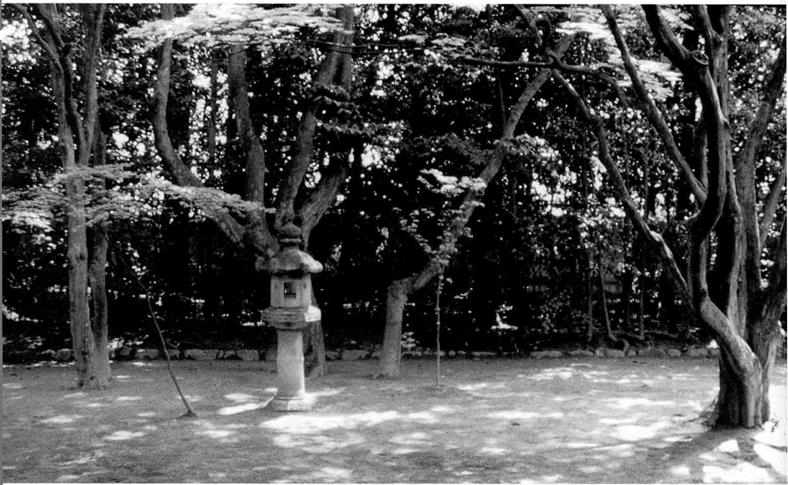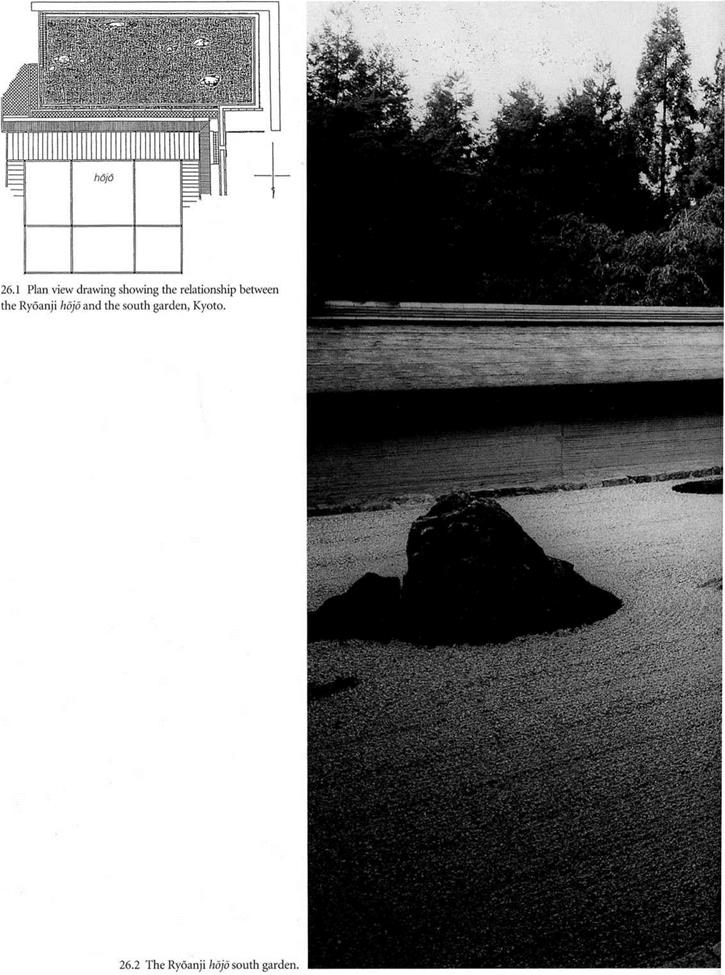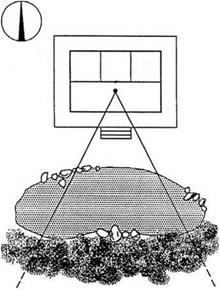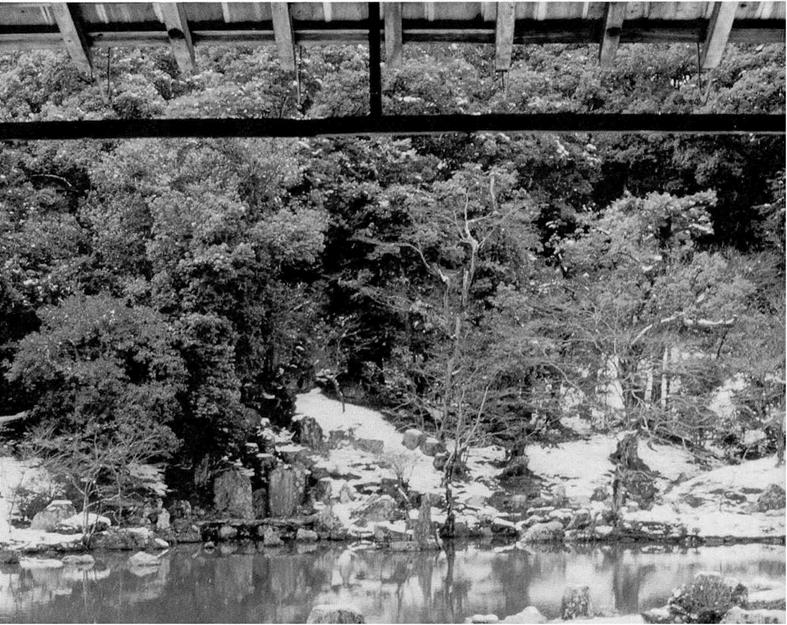The simplification of the formal south garden began in the twelfth century with the cessation of imperial ceremonies and the concomitant loss of the shinderis original function. The genesis of the contemplation garden (kansho niwa) began with the abbreviation of the four basic compositional elements specific to the south garden—the white sand area, the pond, islands, and artificial hills. As we have seen in Sakuteiki’s specification that “where the pond is absent, however, the garden stream should be made especially broad… in order to make the view of the running stream visible from the palace hall floor,” the prototype is not relinquished, hut serves as the basis for abbreviated interpretations.
|
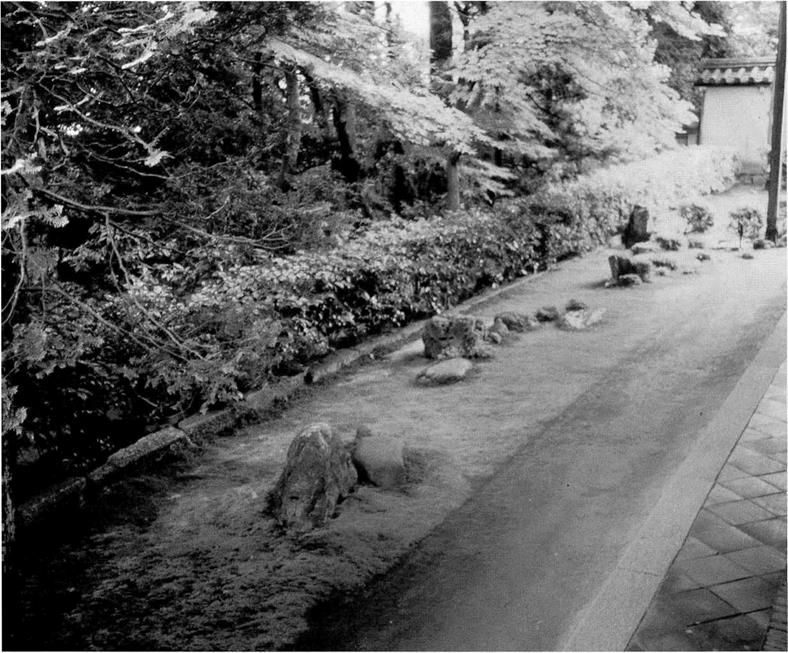
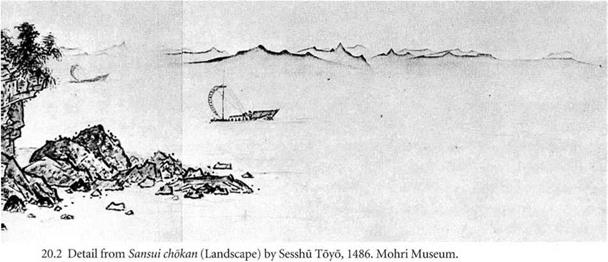

|
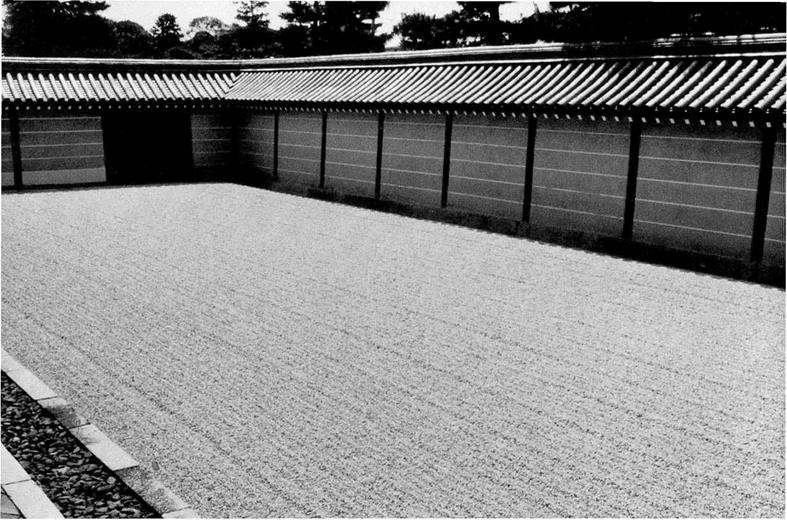
The South Garden in Feudal Zen Temples
The tsukidai (moon dais) in front of Manpukuji’s central Daiyuho Hall is a gravel terrace that was used for the Suirikue—a presentation of offerings of food and drink to restless spirits—and other ceremonies. Likewise, the south garden of the Myoshinji Tokai-an hojo (abbot’s quarters) consists of nothing but coarse white sand, although it is not now, and never was, used as a ceremonial area. While patterned after the ceremonial area of the shinden-zukuri south garden and the tsukidai of Chinese Chan (Zen) temples, the transformation from a functional to a nonfunctional area is most significant. This is the fundamental reason for the shift from the Heian-period naturalistic expressive style to abstract styles of expression characteristic of the Muromachi period.
Although the south garden of the Myoshinji Tokai-an hdjd was constructed during the Edo period, it represents the most basic form of Zen temple south gardens (Figure 21).
Tokai-an’s south garden (shiroroji) omitted most of the main compositional elements of the shinden-zukuri south garden, including the artificial hills, pond, and islands,
and retained only the white sand area. The highly-polished veranda facing the shiroroji served as a ddjo, or training ground for seated zazen meditation. In response to a question as to how the solid white field came to form the basis of these “gardens for Zen practice,” an elderly priest at Tokai-an offered the following Zen koan (conundrum which frees the mind from conceptualizing):
Zen monk: Taking the mountains and rivers as my own, I become them.
Zen master: Taking myself as my own, the mountains and rivers become me.
The coarse white sand can be seen as a canvas on which the image of the “omitted” pond and islands arc depicted freely in, for instance, “the ocean style” or “the river style.” In his book, Nihon no niwa (Japanese gardens), Tachihara Masaaki explains that, “with the development of Zen culture, the dry landscape garden was devised as the Zen monk’s ultimate form of recreation.”3
Muromachi-period Zen gardens also often incorporated distant views of natural features—mountains, water-

falls, even lakes—into the garden’s “picture plane” using a compositional technique called shakkei, or borrowed scenery. A shakkei garden is composed of distinct foreground, middle ground and background planes. The garden site proper comprises the foreground, and the distant feature, the background. The middle ground is composed to frame the “borrowed” feature, which foreshortens the distant view and draws it into the garden, extending the perceived scale of the garden far beyond its own boundaries. Thus the requisite “artificial hills” were added in the form of borrowed scenery (see Figure 22.2).
Fifteen stones of varying size and form placed on a solid field of coarse white sand at the south garden of Ryoanji’s hojo turn the space into а “коди” which is also suggestive of Sakuteikfs Hill Island Style, in which “the hills on the island should show the outline of overlapped hillocks of varied heights…”
The south garden of Shodenji’s hdjd is composed of large and small clipped bushes used in place of stones. Mount Hiei is incorporated as borrowed scenery cropped by a mud wall and a stand of cedars, making the finite space
seem infinite. The south garden of Daitokuji’s Koto-in is a field of moss upon which undulating waves are suggested by light filtered through quivering leaves of a stand of deciduous trees. Despite their abbreviation of many of the basic compositional elements, all these gardens fulfill the Heian-period garden prototype with remarkable interpretations (Figures 22.1-22.3).
When Sakuteikis concept of garden design that recreates the magnitude of nature was confronted with space restrictions, the six basic compositional elements for expressing the prototype—the artificial hills, the pond, the islands, the white sand area, the garden stream and the waterfall— were further refined, which led to the abstract and symbolic interpretations in Muromachi Zen temple gardens.
Tracing the course of the development of garden design from Heian aristocratic residences to Zen temples, it becomes clear that naturalistic and abstract expressions of the same prototype are only superficially disparate, and are in essence the same.
Once popularized, however, and executed by designers who were not themselves involved in Zen practice, these
|
22.3 View from the veranda of Daitokuji Koto-in’s south garden, Kyoto. |
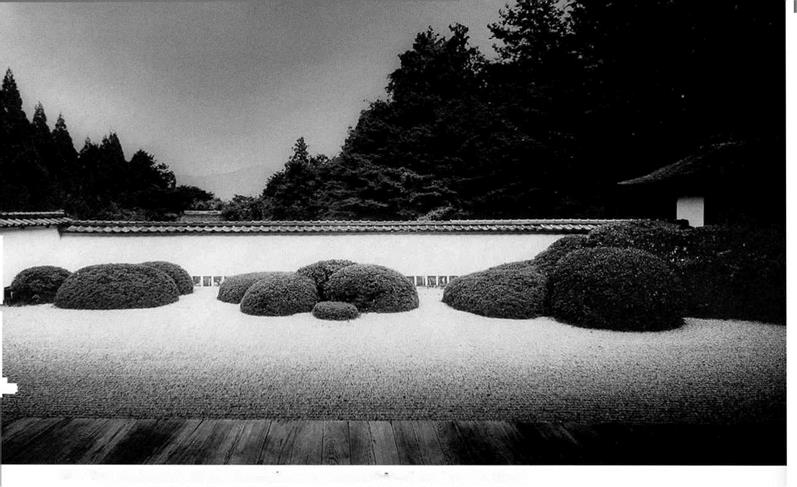
![]() 23 Plan and section schematics showing range of view from the room interior and the veranda of the Zen temple south garden.
23 Plan and section schematics showing range of view from the room interior and the veranda of the Zen temple south garden.
abstract gardens lost their dynamic quality. “Solid white” as a garden design solution became stereotyped, and stone compositions took on fixed formulas (kata) that were passed down as secret teachings.
The Zen temple south garden, as seen at Myoshinji’s Tokai-an and Daitokuji’s Daisen’in, retained the original solid white ground form and functioned as a garden for Zen practice. The compositions of these gardens rarely correspond to the views from the three rooms lining the south face of the hojo. For the viewer seated inside the hall, the white sand is obstructed from view by the veranda; only the hedge or mud wall surrounding the garden, and at times, borrowed scenery can be seen from this position (Figure 23). It is only as the viewer stands and walks that the garden gradually comes into view (Figures 24.1-24.3).
The south garden of the hojo of Joeiji in Yamaguchi Prefecture is another exemplary Muromachi-period garden, in which the shinden-zukuri white sand area is replaced by a stretch of lawn upon which numerous large and small stones are set in groupings of three and five, with the entire scene bordered by a pond in the distance. Like a shinden-zukuri garden, the composition is frontal and unidirectional, corresponding to a seated view from the building interior (Figures 25.1-25.2).
Conversely, the basic composition of the south garden of Ryoanji’s hojo is polarized at the western end and bears no relation to the seated view from the building interior. Its effect is only evident from the veranda. Some hold that the veranda was once connected to a butsuden (Buddha hall) to the west; if this is true, this rock garden must be seen as corresponding to a kinetic viewpoint, in addition to the seated view from the south veranda (Figures 26.1-26.2).
In principle, the south garden of the Zen temple hojo
was a solid white space cut off from the building interior, composed in relation to the south veranda. At times it represented the final scene of the kinetic north garden, usually conceptually rather than spatially, and as such, also had a multifaceted aspect.
The South Garden of Warrior Residences
The zashiki decorative arrangement that came to be known as mature shoin-zukuri, in which the main hall was further divided into the jodan (upper level) and the gedan (lower level) was not yet fully developed in Muromachi – period warrior residences (buke).
A plan-view drawing of Ashikaga Yoshinori’s early fifteenth-century Muromachi villa shows that the building interior was divided into hare (formal) and ke (informal) halves (see Figure 16). The north walls of the small rooms on the informal side were fitted with mairado sliding wooden doors, while the formal south-side space basically retained the shinden-zukuri style, with shitomido shutters on the south wall creating an open, unified garden-to – room environment. The warrior’s south garden was thus composed for a frontal, unidirectional view from the seat of honor at the center of the room, where the highest – ranking person present—master or guest—would sit. Despite the shift in the garden’s function—from a ceremonial role in the Heian period to a purely ornamental or contemplative one thereafter—the fundamental garden composition techniques applied to shinden-zukuri on shallow sites were inherited in these frontally-viewed gardens (Figure 27).
The warrior residence’s south garden took a markedly different approach from the abstractly expressed Zen temple south garden, dispensing completely with the white sand area and condensing the pond, island, and artificial hills. This too was a point of transition to the
|
|
|
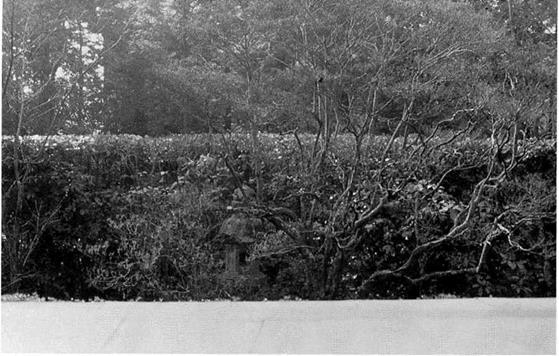
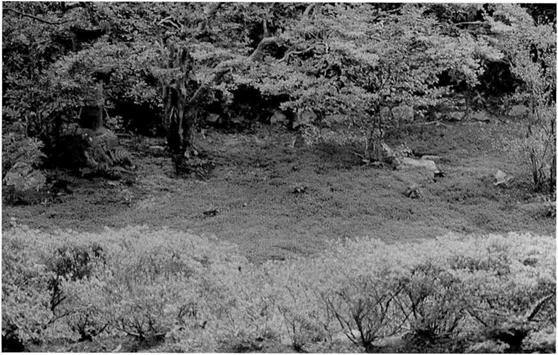
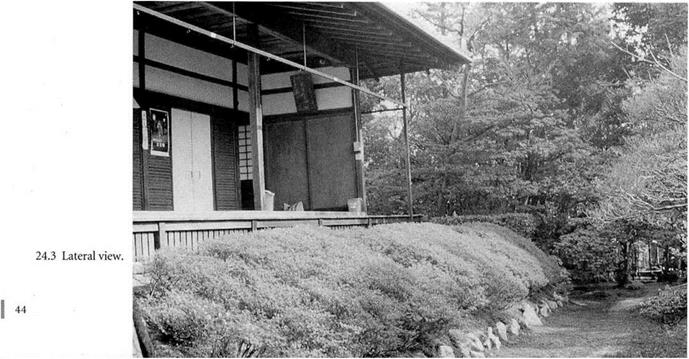
|
|

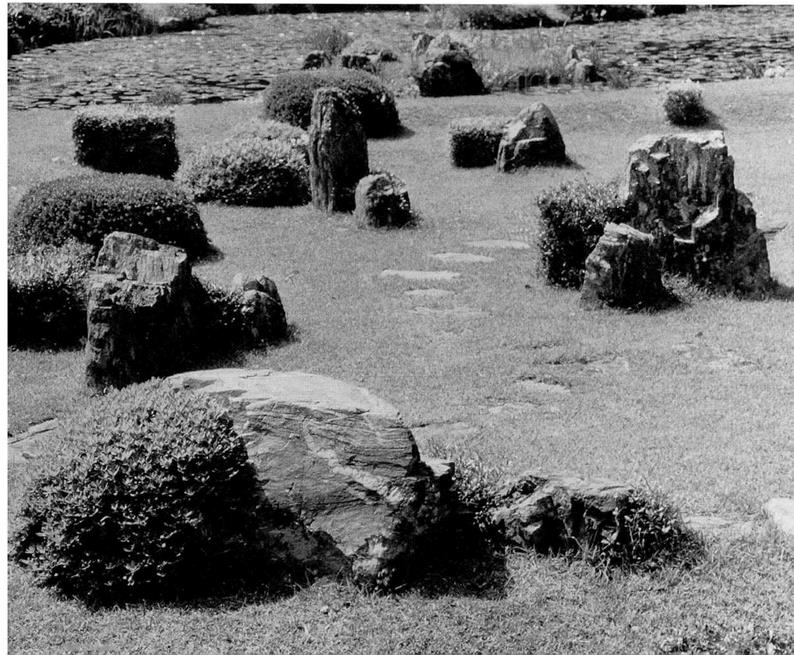
25.1  Plan view drawing of the hojo and south garden of Joeiji, Yamaguchi Prefecture.
Plan view drawing of the hojo and south garden of Joeiji, Yamaguchi Prefecture.
25.2 View from the room interior of the Joeiji hojo s south garden.

|
|
|
|
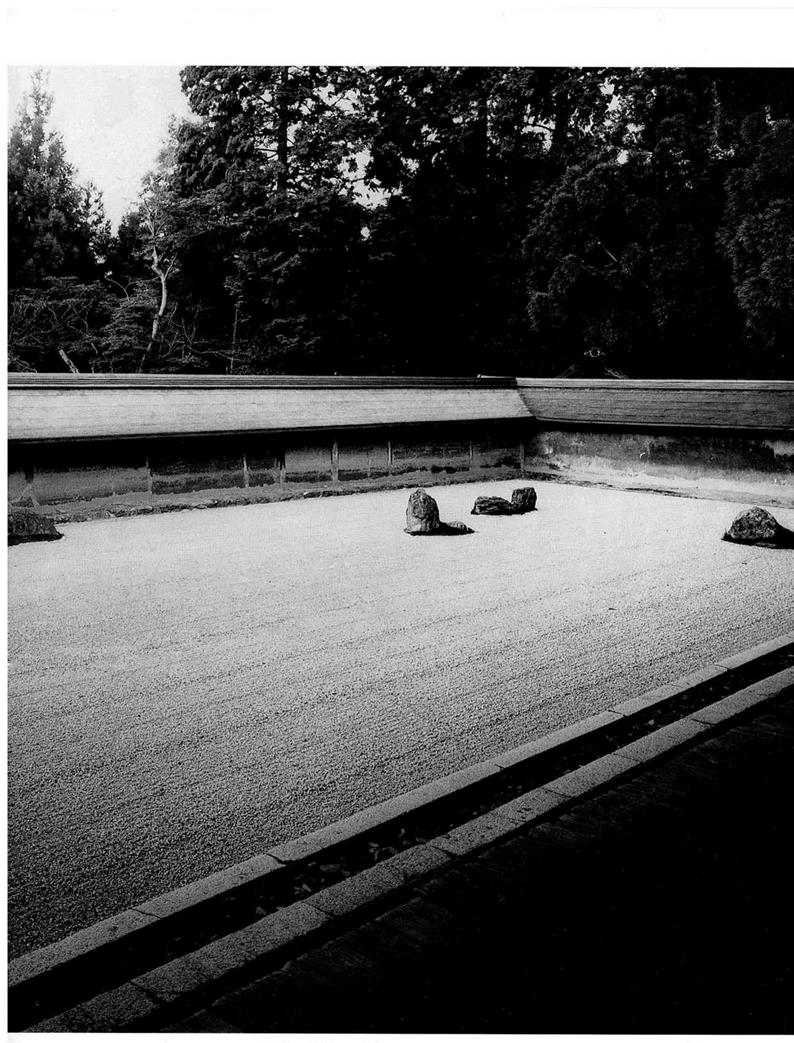
|
|
|
N |
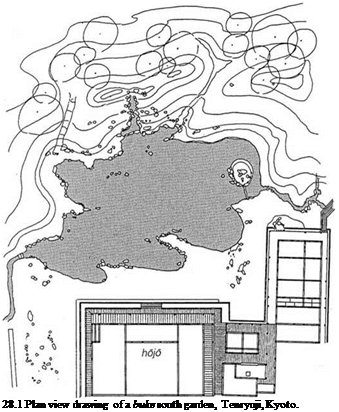 27 South garden of a medieval buke warrior’s residence, composed for seated, center frontal, unidirectional viewing from the interior of an adjacent room.
27 South garden of a medieval buke warrior’s residence, composed for seated, center frontal, unidirectional viewing from the interior of an adjacent room.
|
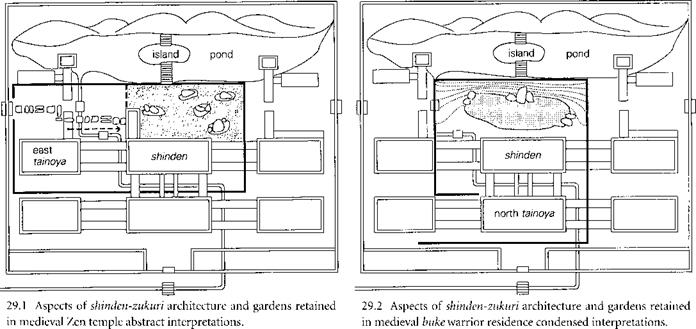
mature shoin-zukuri garden composition of the period to follow. The Muromachi-period gardens of TenryCiji, Echizen Asakurakan, and the former Kuchigi Shdrinji were all designed for contemplation, and for static, unidirectional viewing from the center of an adjacent room (Figures 28.1-28.2).
Although both date from the same historical period, the methods of expression adopted in the south gardens of the Zen temple and the warrior residence emerged as ostensibly antithetical interpretations of the same prototype. This occurrence was very much a function of the times as well as of the Japanese phenomenon of the garden design’s being linked to the functional aspects of the building (Figures 29.1-29.2).
These divergent forms of expression were actually two manifestations, at opposite ends of the spectrum, of the same concept. This is the same process described earlier regarding yd, in which the inherently abstract character of stylized forms is implemented differently in accordance with different site conditions and functional requirements, and thus a single stylized form could be expressed in diametrically opposed interpretations.
The influence from imported culture during the medieval period—the direct import of Chinese paintings and wares—was of a different quality than that of Heijo-kyo, where the Tang capital and palaces were transmitted in image. Assessment standards were set and documented by Japanese connoisseurs at the early import stages to
handle the large quantities of goods. According to Kundaikansochoki, a late-Muromachi period secret document on the connoisseurship and display of Chinese paintings and wares, the court academic paintings of Southern Song Emperor Flui Cong were assessed at a value comparable to that of the freer ink monochrome paintings of Muqi, and likewise celadon and white high – fired pottery was appraised coequally to oil-spot tenmoku (yUhen) stoneware—value standards unthinkable to the Chinese. This uniquely Japanese approach to assessment is not unrelated to the ostensibly antithetical abstract and representational expressive forms taking their respective positions in garden making.

